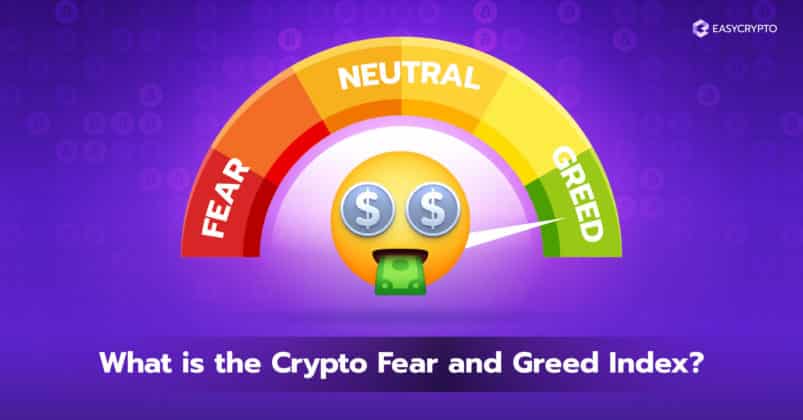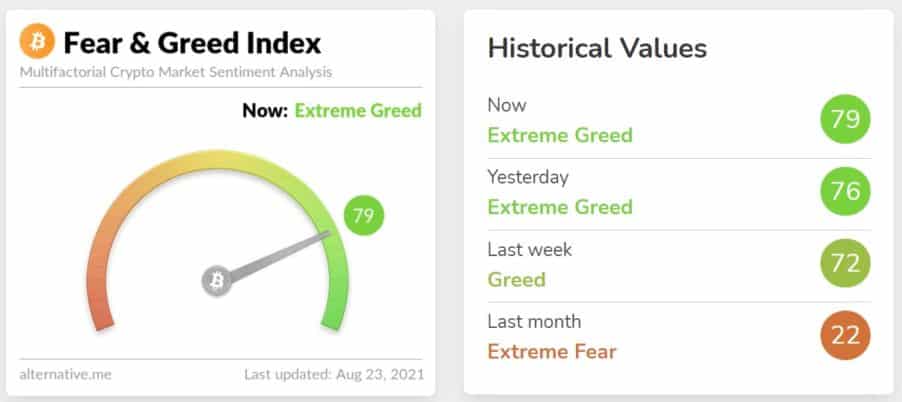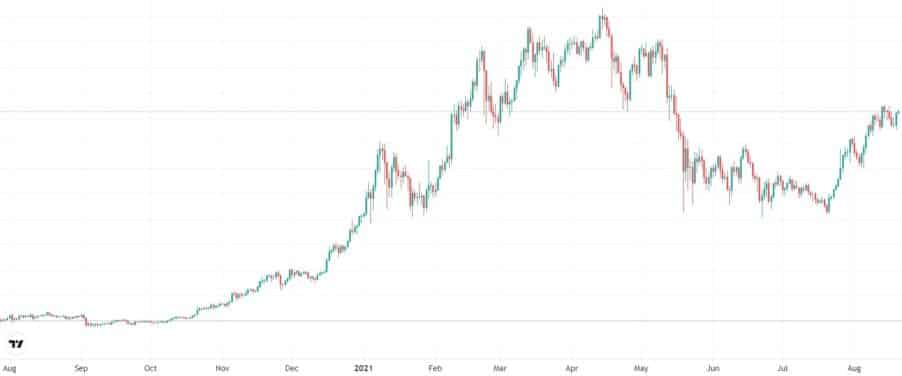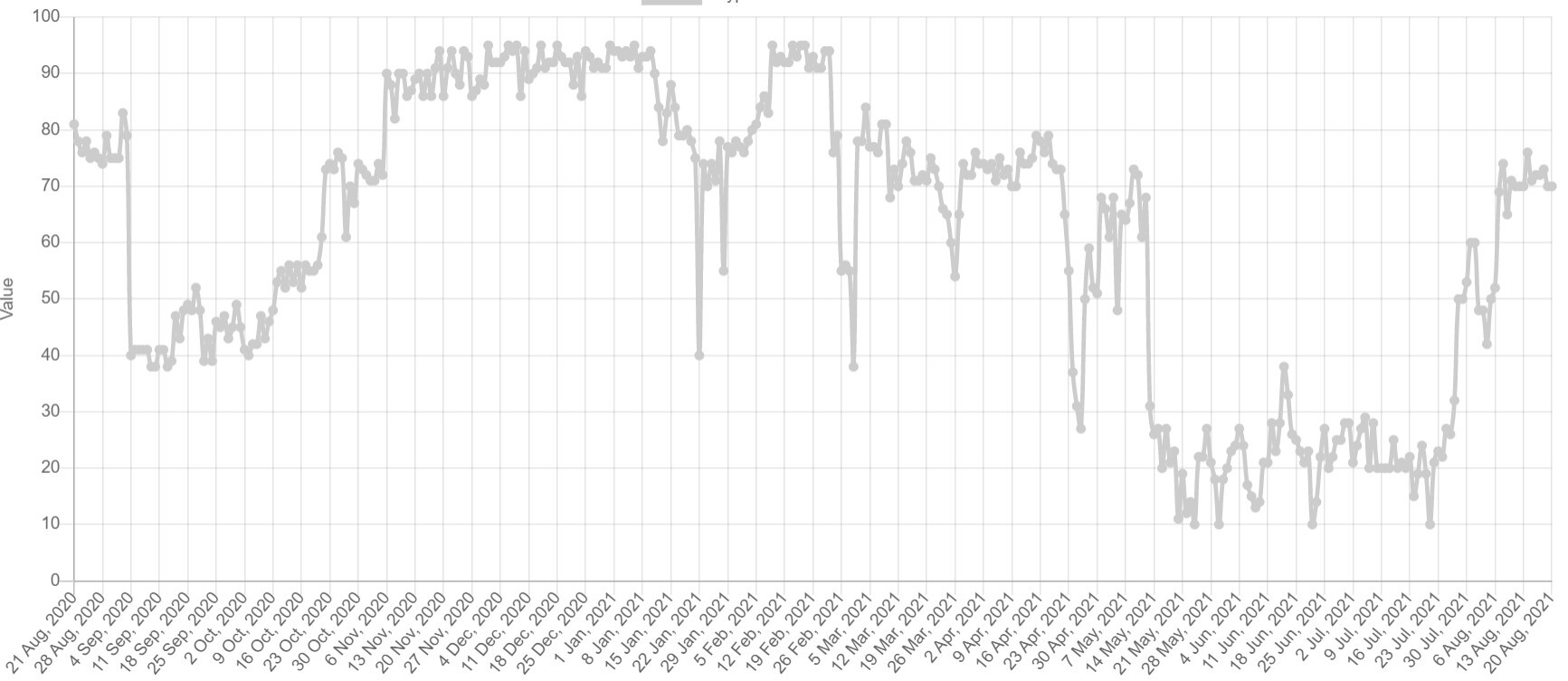What is the Crypto Fear and Greed Index?
While the price movements seem wild and erratic, crypto traders have noticed quite a few consistent patterns, and have made some generalisations about the market.


When we talk about trading cryptocurrencies, short term price volatility is important to watch out for. While the price movements seem wild and erratic, crypto traders have noticed quite a few consistent patterns, and have made some generalisations about the market.
One of which is that the short term price movement tends to be largely influenced by market sentiment, or the collective emotions of all the trading participants in the market. For example, starting 19 May 2021, there was a lot of fear and uncertainty about China’s crypto crackdowns, driving the price of Bitcoin and altcoins down.
Contrast this to November 2020, when new buyers hop into the trendy lockdown activity of trading cryptocurrencies. Some appeared to be greedy and buying large volumes of crypto at once, driving the market up for all crypto assets.
New to cryptocurrencies? Start with our 101 guide on crypto.
What is the Fear and Greed Index?
The crypto market isn’t the only market that is influenced by emotions. The concept of the Fear and Greed Index was first developed by CNNMoney to model the traditional financial market’s mass psychology.
The challenge is, of course, not being able to ask each and every trader which assets they will buy and sell next.
So, they must look at several technical indicators such as the market momentum and trading volume to figure out if the majority of traders are willing to buy or sell — to drive the price upwards or downwards, respectively.
The Fear and Greed Index is a score between 0 to 100, where any score below 30 indicates fear, above 60 indicates greed, and it indicates a neutral sentiment between 30 to 60. Note that the original index wasn’t designed to measure the crypto market sentiment.
The index has been useful in the stock market before Bitcoin was even invented. For example, when the US stock index S&P 500 fell after the bankruptcy of the Lehman Brothers, which triggered the 2008 global financial crisis, Fear and Greed Index sank to a score of 12, indicating extreme fear.
Is there a Fear and Greed Index for cryptocurrencies?
We cannot use CNNMoney’s Fear and Greed Index for cryptocurrencies, because the crypto market is not tied to the traditional financial markets. On the other hand, the stock market, futures market, Central Bank Treasury bonds, and mortgage are all linked together.

This doesn’t mean that the crypto market cannot move in the same direction as the stock market, for example. However, the unregulated crypto space simply doesn’t correlate with the activities and market sentiment of the legacy financial system.
Fortunately, there is a Crypto Fear and Greed Index, formulated by software developers Gregor Krambs and Victor Tobies, who published this index for free on their website.
Other websites may feature something similar, but this is the first of its kind, published with a detailed explanation of how it works.
Related: Bitcoin Investment Guide for Latecomers.
How effective is the Crypto Fear and Greed Index?
Crypto traders are already well-equipped with the more common technical indicators, like the moving average, relative strength index, and average true range, among others.
Of course, none of these indicators are perfect, and it’s often useful to cross-reference multiple indicators to create better trading decisions.
The Crypto Fear and Greed Index actually reflects the Bitcoin market pretty well. We can see the response of the index along with the price of Bitcoin when stacked together below.
This is the Bitcoin/USD price between mid-August 2020 to the time of writing in mid-August 2021.
Learn more: Cryptocurrency Technical Analysis For Trading.


In this time frame, the general market sentiment is bullish on Bitcoin, which is reflected on the price chart as well. There were a few dips in price from time to time, as the market took profit, creating short dips in market sentiment.
Here are some of the many instances where the Bitcoin price is correlated with the index score:
- First week of September 2020, a sharp drop in price led to a drop in the index from 80 to 40.
- From November 2020 onwards, the index indicates confidence and strong greed, while the price continues to inflate.
- In January 2021, the first massive profit-taking occurred, creating a flag pattern in the price chart. At the same time, the index scores all the way down to 40, but this isn’t indicative of a strong urge for the market to sell out.
- In April 2021, the price sank lower than the previous low, and the index began to indicate strong fear as the score reached as low as 30. The rebound sentiment wasn’t as strong, scoring no more than 70. At the same time, the price failed to reach an all-time high.
- Fear and uncertainty towards regulations and celebrity comments on Bitcoin caused some incredible fear with the index score of 10. At the same time, Bitcoin’s price plummeted and stayed around 30,000 USD.
This week, as demand for Bitcoin returns, the Crypto Fear and Greed Index is indicating a return of the greedy sentiment as it scores well over 60.
An important thing to note is that while both the Bitcoin price and the index are highly correlated, we cannot form a causational relationship between the two.

It’s possible that the price affects market sentiment, and therefore the index, making the index a lagging indicator, much like many other technical indicators in existence. If the market sentiment affects the price, then the index can possibly become a leading indicator.
In reality, the price and market sentiment can form either a positive or a negative feedback loop — positive sentiment can cause higher prices, which causes more positive sentiment, and the opposite is true. It’s difficult to know which one moves first — the sentiment or the price?
However, the index is only an estimate of what we define as market sentiment. In reality, the index is measured by several lagging indicators, which makes it less likely to become a leading indicator.
See also: Active vs Passive Crypto Investment: the Pros and Cons.
How is the Crypto Fear and Greed Index measured?
The Crypto Fear and Greed Index is measured by six metrics, each weighted differently:
Volatility (25%)
Volatility is measured by comparing the maximum drawdowns (drop in price) of Bitcoin at present, with its corresponding average drawdowns over the last 30 days. The developers argue that a rise in volatility (higher frequency in price drops) is a sign of a fearful market.
Market Momentum and Volume (25%)
The market momentum is measured by indicators such as the relative strength index, which infers that an asset is either overbought or oversold.
The average of this, along with the average trading volume over 30 days, is combined. An overbought market with a high volume would indicate a greedy sentiment.
Bitcoin Market Dominance (10%)
The developers believe that “a rise in Bitcoin dominance is caused by a fear of (and thus a reduction of) too speculative altcoin investments.”
On the other hand, if Bitcoin dominance shrinks, investors are willing to put their money into more volatile and speculative altcoins, a sign that the market is bullish on the overall crypto space.
Social Media Mentions (15%)
The frequency of various hashtags on Reddit and Twitter are analysed, along with social media engagement metrics such as the number of shares, likes, and comments.
“An unusually high interaction rate results in a growing public interest in the coin and in our eyes, corresponds to a greedy market behaviour,” according to the developers.
Search Trends (10%)
The developers used Google Trends to look at the relative trends of “Bitcoin” related search queries. The context of the search is often examined to avoid mistaking a negative sentiment for a positive one. An example that they gave is the query “bitcoin price manipulation” (+1550% up in 2018), which was deemed as a sign of fear in the market.
Surveys (15%)
The developers no longer use surveys to measure the index, however “it was quite useful in the beginning of [their] studies”. With a sample of 2000-3000 votes, the developers could start getting a general reaction of the public towards the market activity.
What are the weaknesses of the Crypto Fear and Greed Index?
Like all studies and surveys, the Crypto Fear and Greed Index is not the ultimate answer to market speculation. Firstly, the developers did not provide a research paper or documentation that highlights the reasoning behind their choice in technical indicators and social media metrics.
The descriptions of how the index works on the developers’ website is not detailed enough to be replicable by peer review. Peer review in academic research is important to verify the reliability of findings.
Given that this index is only applicable to Bitcoin, it would be interesting to apply the same approach for altcoins.

As much as 60% of the score is based on technical analysis, which is supplemented by social network data, accounting for 40% of the index total score. Social network data is never used in CNNMoney’s Fear and Greed Index. This is a new application that has not been proven within the context of the liquid asset market.
The weight coming from social engagement metrics, however, could be lower as social media and search trends are threatened by algorithm and policy updates by companies who own the platform.
Read also: Golden Rules for Crypto Risk Management.
Crypto Fear and Greed Index — the verdict
Although the Crypto Fear and Greed Index is highly correlated with the price of Bitcoin, a causational relationship cannot be made. This is where traders need to be careful and compare their findings with the other, more “traditional” technical indicators.
Simply, a high fear index (low level of greed) does not promise us that this is the right moment to buy. Likewise, a sinking price couldn’t promise a rebound in the price.
If we still need to “wait and see” where the price is going, we might as well only pay attention to the price, much less the Fear and Greed Index.
Like all lagging indicators, the Crypto Fear and Greed Index is useful if we already know the historical pattern of the market. While it’s not perfect, it is a good experiment that is worth further exploration.
Share to
Stay curious and informed
Your info will be handled according to our Privacy Policy.
Make sure to follow our Twitter, Instagram, and YouTube channel to stay up-to-date with Easy Crypto!
Also, don’t forget to subscribe to our monthly newsletter to have the latest crypto insights, news, and updates delivered to our inbox.
Disclaimer: Information is current as at the date of publication. This is general information only and is not intended to be advice. Crypto is volatile, carries risk and the value can go up and down. Past performance is not an indicator of future returns. Please do your own research.
Last updated September 5, 2023





